

Istine Rodseth Swart is an administrator for the KLC. Unless otherwise specified, all artworks and photographs by Tim van Vuuren (Instagram: @timothyvanvuuren, email: timothyjvv@gmail.com).
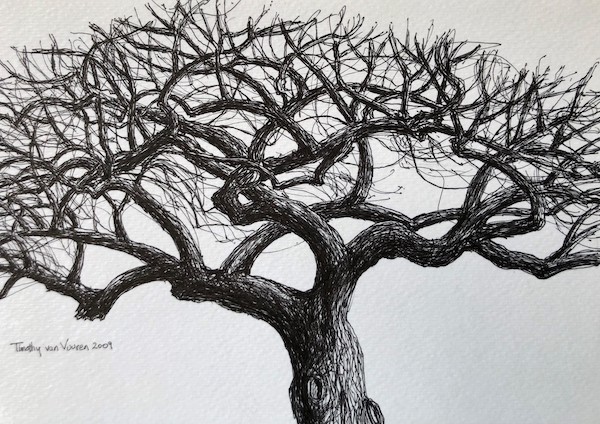
In conversation with Istine Rodseth Swart, the award-winning ceramist and multi-faceted artist Timothy van Vuuren, from Johannesburg, South Africa, shares aspects of his life’s journey in art.
Istine Rodseth Swart: Your love for art in general and enthusiastic pursuit of several art forms has extended over decades and is a major part of who you are. When did you become aware of your artistic gifting, and that it needed to be expressed so diversely?
Tim van Vuuren: I have enjoyed drawing since I was at school. At the age of twenty-five I started drawing seriously, which I did for a year before starting to paint. My first efforts were amateurish, but with guidance from some professional artists my work slowly improved. Some of these artists are Gert Swart, Walter Hayn and the late Tony Strickland. Originally, I worked from drawings done in plein air or from my own photographs.
IRS: How do you accommodate your interest in and pursuit of the rather unusual combination of making pottery, drawing, painting and flower arranging?
TvV: I spent thirty-five years working in the financial services industry before retiring to pursue art full time. During this period, it was difficult to find time to make art. However, because drawing is an immediate form of art, I drew whenever I had a moment and now have several drawing books of drawings apart from many other drawings on sheets of paper. Some of these drawings done in the last 45 years I still use today in my art.
I made time to paint at night and on occasion would paint late into the night. I also wanted to work with clay, so I started learning pottery at Sevendoone Pottery in Pinetown. After several years, having studied all aspects of ceramics, I purchased a wheel and an electric kiln and set up a studio at home.
In 2008 we moved to Underberg where we further developed a wonderful garden that came with the house we bought. There my love for flowers and arranging them grew. I joined the Underberg Garden Club in spite of being one of a handful of men in a group of 100 per monthly meeting. Although only an occasional gardener, I love gardens and there I learnt more about them: about trees and vegetables, growing and caring for flowers, as well as flower arranging.
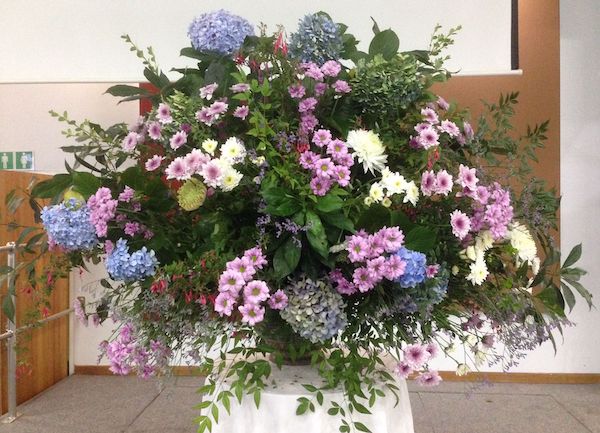
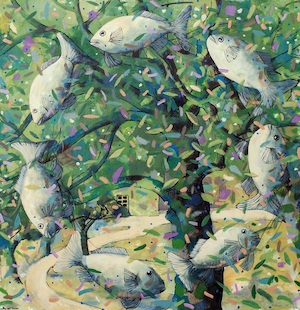
IRS: Themes recur in your pottery, drawing and paintings: trees, houses, fish, for example. What lies behind your preoccupation with these themes?
TvV: I love landscape paintings, particularly if they include trees and some human presence in the form of villages, towns, buildings, suburbia, etc. The sleek shape and freedom of movement that fish have has always intrigued me. As far as ceramics are concerned, I made one-off decorative pieces often using the similar images or themes as I used in painting and vice versa.

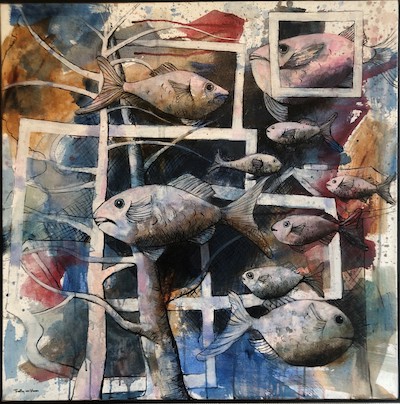
IRS: You have not only created artworks, but have shared your expertise, have played a role in associations and have been a student throughout your artistic journey: teaching, serving on committees and in associations and attending classes. How did you benefit from these activities and what are some of your most significant and rewarding experiences and affiliations?
TvV: I learnt a great deal from all these activities, but especially from teaching drawing, painting and ceramics. I started my students on drawing and concentrated on capturing the forms of objects, primarily using hatching, before going on to teaching all aspects of painting. I cannot over-emphasize the importance of drawing to an artist. It is vital to use drawings to formalize your subject; in fact, I think drawing is the lifeblood of an artist.
In addition to making and teaching ceramics, I was a member of Ceramics SA for many years and had the privilege of serving as the chairperson of the KwaZulu-Natal region for two years.
IRS: Wherever you resided you have been active in your community, and your church family, in particular, has benefitted from your artistic talents. Tell us something about your involvement in your church communities.
TvV: Apart from being involved in regular church activities, I started doing flower arrangements at our church in 1997 when we moved to Hillcrest and continued to do so at churches in Underberg, Howick and now Johannesburg where I am the only man on the flower roster.
I was a congregant in the Pinetown church where Craig Bartholomew served as a young pastor. It was an enriching experience to be part of the Christian Worldview Network that he initiated and to benefit from his commitment to artists and the arts. I took part in the arts festivals and CWN conferences that were arranged at that time and contributed to the original The Big Picture that Craig started.
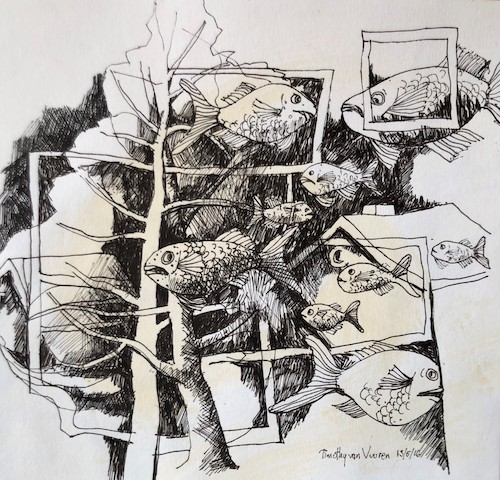
IRS: You have always had a lively interest in books and a curiosity about the work of other artists: past and present, local and international. How would you describe the role of books in your life, and are there any artists that have influenced your work significantly?
TvV: There are many artists and art books that have inspired me to be more creative. Some of the art and artists on Instagram have also been a constant inspiration. If I had to single out one book it would be Landscape Painting Now, subtitled Pop Abstraction to New Romanticism, by Barry Schwabsky (Distributed Art Publishers, 2019). This book covers realism and abstract landscape painting from the 20th century and includes work done in the 21st century. The most interesting chapter for me is titled “Constructed Realities.” I realized that from the 1980s I had occasionally made up my own landscapes. I suppose these paintings are constructed realities. Craig might remember The Red Maze dated 1983 and exhibited at the arts festival at Christ Church in Pinetown. But then most contemporary artists create their own reality, a myriad of styles, from realism to abstract. Look at Gert Swart’s sculptures: his own wonderfully creative reality, for which he is now using some brilliant colour combinations.
IRS: Making art is in many respects a solitary pursuit, but as we have seen, you were and are involved with friends, fellow artists and art groups. How do you balance the solitary and social aspects of your artistic life?
TvV: I agree that making art is a solitary pursuit. However, I have attended many pottery/ceramic workshops given by brilliant and successful ceramicists. These workshops have been an invaluable learning process for me. At the Howick Arts Society (HARTS), I did a workshop on drawing. One does learn much from workshops, but ultimately one makes art on one’s own. This requires self-discipline, and I think most artists are self-motivated to be creative.

IRS: Clearly you have always had a very strong motivation and drive to practise art since you continued to do so alongside your career in finance before retirement. How did you find time to create art, especially different forms of art, while working and taking care of your family?
TvV: This was difficult at times and frustrating. In my business I would be on my way to a client, sometimes looking at an inspiring landscape but not having the time to stop. So many landscape paintings were only made in my mind and never became a reality. Maybe this led me to creating my own realities for painting and pottery purposes. One has to make time to be creative.
More recently after moving house four times in three years I decided to concentrate only on painting. Logistically carting a kiln around that weighs the same as a piano became onerous, hence becoming one of the factors that led me to selling all my pottery equipment to one of my students.
IRS: What difference does being a Christian make to the way in which you create artworks and operate within the art world.
TvV: Firstly, I have to say that if one has any creative gifts or talents, they are always God given. There are many verses in Scripture alluding to this fact (e.g., Ex 31:1–6). So, I believe we should be in prayer about our artworks and seek God’s wisdom in the creative process. There could be some controversial subjects in the creative process, but we should strive to be God honouring with our creations. We should be living a life dedicated to our Lord and God.
